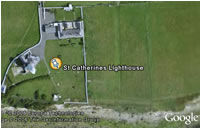 Google Earth/Maps
Google Earth/Maps
If you haven’t heard of AJAX (Asynchronous Javascript And Xml) you’re not a techie. It’s the buzzword of the moment and Google Maps uses it brilliantly (Google Mail is another example). It’s pretty old technology that uses the power of the client to locally render information delivered by the server. With Google Maps the browser loads a small Javascript application and sends data/requests back to the server which then delivers the next bit of data which the client then renders i.e. moving around a map.Google Earth is the next step in actually showing satellite data of the area you’re looking at (you can see cars parked in your street). Why would they want to offer these services? More advertising. Do a map search and you can also see information on local services (or restaurants, petrol stations, bars etc).They are both very powerful, easy-to-use apps. Google Calendar
Google’s latest AJAX application, Outlook calendaring but hosted centrally so it can be accessed from anywhere. Of course it’s more than just a calendar as it allows subscription to other calendar/events, sharing of calendaring information and even mobile synchronisation.Privacy
There’s been a lot of media interest in what information Google store about you as they could abuse it and the authorities could request it to see what you’ve been doing. 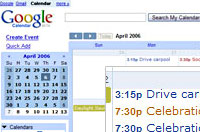 It’s uncertain how much information they do store, but it could be quite considerable. They actually might not know it’s you personally, but your computer. Google uses cookies which are used to track your personalisation settings, but they can store a lot more info, though Google are likely to just use the cookie as the identifier which enables them to quickly personalise things.Just looking at the information they could store when you do a search, it’s the search criteria itself, then which sites you clicked through to. But that can be combined with other info like what Google Map info you looked at, who you emailed through Google Mail and your previous search history. That may lead to a bleak picture if you’re committing illegal acts.The other side to it all is that the processing of all this information is extremely resource hungry and though Google are particularly good at correlating information, they might not bother. They will for some aspects, but most of the time it’s probably not worth it and they’ll keep succinct summarized information.If the authorities want to know what your doing, it’s actually much easier for them to go to your ISP and request the information from them (if they are running caching equipment which speeds up Web access for all users, they don’t just know what searches you’ve been doing, but every Website you’ve accessed and everything you’ve down or uploaded).The Future
It’s uncertain how much information they do store, but it could be quite considerable. They actually might not know it’s you personally, but your computer. Google uses cookies which are used to track your personalisation settings, but they can store a lot more info, though Google are likely to just use the cookie as the identifier which enables them to quickly personalise things.Just looking at the information they could store when you do a search, it’s the search criteria itself, then which sites you clicked through to. But that can be combined with other info like what Google Map info you looked at, who you emailed through Google Mail and your previous search history. That may lead to a bleak picture if you’re committing illegal acts.The other side to it all is that the processing of all this information is extremely resource hungry and though Google are particularly good at correlating information, they might not bother. They will for some aspects, but most of the time it’s probably not worth it and they’ll keep succinct summarized information.If the authorities want to know what your doing, it’s actually much easier for them to go to your ISP and request the information from them (if they are running caching equipment which speeds up Web access for all users, they don’t just know what searches you’ve been doing, but every Website you’ve accessed and everything you’ve down or uploaded).The Future
Google are encroaching into territory that used to be securely within the MS domain, desktop search and now IM. In the IM market they’re using open protocols which will gather traction from both the open source community and allow interesting applications to spawn from it.With things like Google Maps/Earth, searching has been moved from the electronic (or Internet) world to the real world. Google are already toying with mobile, but you can be sure that’s the space they’ll enter next.Imagine your smartphone or PDA with a local Google application installed. As you move around, it uses location based services and delivers relevant local information straight to the device. Looking for a restaurant? It’s got Google Talk too, so you can chat or really talk to the restaurant and book a table before you get there. Google are going to dominate the desktop and the mobile space and it’ll all happen in the background.Microsoft must be quaking as Google are their biggest threat.Let’s hope the Google Empire is benevolent and doesn’t become an evil behemoth.References
GMail Drive shell extension
Content
Content in its shift to become digital
Google, The Next Dark Empire? Pt2
Personal Train Timetables Review: For Mobiles, PCs and Palms (85%)
 If you’re a regular train traveller across the UK, or you’re planning a holiday involving lots of different journeys, keeping track of all the various train times can be a bit of a pain.
If you’re a regular train traveller across the UK, or you’re planning a holiday involving lots of different journeys, keeping track of all the various train times can be a bit of a pain.Normally, you’d have to lug around a bag full of separate timetables or fork out for those spoddy jumbo timetable books often seen in the clammy paws of trainspotters, but thanks to the cunning skills of the German railway Website bahn.de, you can download customised timetables direct to your PC, phone or Palm handheld.
Setting up individual timetables is simplicity itself – just type in your start and destination stations and then select the date period you want journey information on.
Then tick off what days of the week you want included in your timetable along with the outward/return journey times (or select ‘whole day’ for the all trains) and select what modes of travel you want included or excluded from your file.
Next, you have to you choose what format you want your timetable in: PDF, PDB (for Palm handhelds) and J2ME for Java mobiles, downloadable as a zip file or via a WAP URL.
 Then it’s a case of bashing the ‘create’ buttom and waiting for a few minutes as the Teutonic technlogoy does it thing, before being presented with links to your timetable (you can elect to download the timetable directly from the site or have the files emailed to you).
Then it’s a case of bashing the ‘create’ buttom and waiting for a few minutes as the Teutonic technlogoy does it thing, before being presented with links to your timetable (you can elect to download the timetable directly from the site or have the files emailed to you).Free Palm viewer
Palm users can also download a highly functional free custom viewer called, appropriately enough, Personal Viewer, created by the German company that powers the timetable engine, HaCon. This small download provides a simple interface serving up enough timetable-related data to give train buffs a moist spot or two.
This small download provides a simple interface serving up enough timetable-related data to give train buffs a moist spot or two.Users can store as many timetables as they like on their Palm (the files can also be run from the card to save space), with the tabbed interface letting travellers select their journey and time of travel and then see available trains, journey details and stops on the way – there’s even an indication whether snacks will be available on the selected train!
We’ve been using this program on our Palm handheld for years, and can thoroughly recommend it – especially as it’s totally FREE!
Overall score: 85%
BBC World Cup Online Via Broadband
 The BBC Sport Website will be carrying all of the World Cup 2006 football matches – Live. It will be only open to UK broadband users (or non-UK clever clogs who can set up a proxy or two).
The BBC Sport Website will be carrying all of the World Cup 2006 football matches – Live. It will be only open to UK broadband users (or non-UK clever clogs who can set up a proxy or two).Not content to having such a major, big ticket event being carried online, broadband uses will have the advantage of being able to listen to live commentary from Radio Five Live, while reading the kick-by-kick accounts in text.
 Panic in the network departments of companies around the UK will be settling in tomorrow morning as they realise quite how many of the employees will be sneaking a watch of the matches while at work. We suspect that bosses will be sanctioning, or possibly even buying TV for the staff to watch, rather than have their networks melt around them.
Panic in the network departments of companies around the UK will be settling in tomorrow morning as they realise quite how many of the employees will be sneaking a watch of the matches while at work. We suspect that bosses will be sanctioning, or possibly even buying TV for the staff to watch, rather than have their networks melt around them. The BBC are keen to point out that this won’t be the first time they’ve shown football or even sports events online. The final of the Club World Championship between Liverpool and Sao Paulo was shown in 2005, as was the Athens 2004 Olympics. They also plan to stream Wimbledon for the first time this year.
The BBC are keen to point out that this won’t be the first time they’ve shown football or even sports events online. The final of the Club World Championship between Liverpool and Sao Paulo was shown in 2005, as was the Athens 2004 Olympics. They also plan to stream Wimbledon for the first time this year.While this is clearly a major headline grabber, we do wonder how many people will be actually be watching the games on their computer. What is more certain is that not many will be using it as their major TV source (except us of course). It’s more likely that they’d just run it alongside their TV.
The BBC isn’t having it all their own way. We know of several National newspapers and some local papers that will be sending journalists out to the World Cup to file video reports. This World Cup will be the most tech’d up so far.
FinePix Z3 Zoom For The Laydees
 Thinner than a whippet with Montezuma’s Revenge, Fujifilm’s new FinePix Z3 sports a 5.1 million pixel sensor, ISO reaching down to the dim lights of 1600 and a 36-108mm (3x), F3.5 – 4.2 lens.
Thinner than a whippet with Montezuma’s Revenge, Fujifilm’s new FinePix Z3 sports a 5.1 million pixel sensor, ISO reaching down to the dim lights of 1600 and a 36-108mm (3x), F3.5 – 4.2 lens.Apparently created with the laydees in mind, this minor update to the Z2 camera comes with improved resolution, an Intelligent-Flash mode and an improved 2.5-inch screen, with the camera available in silver, metallic blue and girly-girly light pink.
Fluffing up their announcement with a bit of cod-science, Fujifilm reckon that their research has revealed that most photos taken by women are ‘people pictures’* snapped in low light situations and in close proximity to the subject – the kind of photos that are notoriously hard to grab without camera shake or bleaching out faces..
 (*A quick straw poll around the office found this claim to be total bollocks, by the way).
(*A quick straw poll around the office found this claim to be total bollocks, by the way).We’re sure that the ladies of the world will be lining up to thank Fujifilm for the Super CCD and Real Photo Processor II in the Z3 which combines with the camera’s high sensitivity (up to ISO1600) and Intelligent-Flash system to help banish those low-light photo blues.
Fujifilm’s Intelligent-Flash system claims to work by combining a well-exposed background and ‘natural skin tones’ on subjects in the foreground, with a ‘Dual-Shooting Mode’ blasting off two consecutive shots (one with flash and one without flash) to see which comes out best.
Rounding off the feature set is 14 pre-programmed scene positions, high resolution (230K Pixels) 2.5 inch LCD screen, 10 MB internal memory and ‘TV-quality’ VGA movie recording of 30 fps with sound
Availability and pricing to be announced.
 Specifications:
Specifications:
Sensor – 5.1 million effective pixels
Image sizes – 2592 x 1944, 2736 x 1824 (3:2), 2048 x 1536, 1600 x 1200, 640 x 480
Movie clips – 640 x 480 @ 30fps, 320 x 240 @ 30fps, Mono sound
File formats – JPEG Exif v2.2, DPOF, AVI Motion JPEG
Lens – 36 – 108mm equiv, F3.5 – 4.2
Image stabilization – No
Conversion lenses – No
Digital zoom – up to 5.7x
Focus – Auto focus, Normal: approx 60cm – infinity, Macro: approx 8cm (wide)
Metering – TTL 256 zone
ISO sensitivity – Auto, ISO 64 – ISO 1600
Shuttter speed – 4 – 1/1000 sec
Aperture – F3.5 / F5.0 / F8 3 steps
 Modes – Auto, Anti-Blur, Scene Position, Macro, Movie, Burst / Continuous
Modes – Auto, Anti-Blur, Scene Position, Macro, Movie, Burst / Continuous
Scene modes – Natural Light, Natural Light with Flash, Portrait, Landscape, Sport, Night, Fireworks, Sunset, Snow, Beach, Museum, Party, Flower, Close-up, Text
White balance – Auto, Manual (Fine, Shade, Fluorescent Light (Daylight, Warm White & Cool White), Incandescent Light
Self timer – 2 or 10 sec
Continuous shooting – Top-3 (max 2.2 fps up to 3 frames), Final-3 (max 2.2 fps up to 3 frames), Long-period (max 0.7 fps up to memory card size)
Flash – Auto, Red-eye reduction, On / Off, Slow sync, Red-eye reduction + slow sync
Range – Wide approx 0.3 – 3.0m, Tele approx 0.6 – 2.3m
Viewfinder – No
LCD monitor – 2.5-inch, 230,000 pixels
Connectivity – NTSC / PAL, USB 2.0 High speed
Storage – xD-Picture Card, 10MB internal memory
Weight (no batt) 130 g (4.6 oz)
Dimensions 92.7 x 56.7 x 27.8 mm (3.6 x 2.2 x 1.1 in)LG’s KG810 Announced
 LG has unveiled the KG810 clamshell phone; a super slim, quad band GSM handset which will be sold in Asia, China, Europe and CIS markets.
LG has unveiled the KG810 clamshell phone; a super slim, quad band GSM handset which will be sold in Asia, China, Europe and CIS markets.Although we’re not generally fans of the clamshell phones (our attempts to casually flip the things open one-handedly invariably saw the phone flying off into the distance), but the KG810 is certainly a bit of a looker.
Like the slider KG800 chocolate phone, the KG810 features the same external “Infrared Sensor” buttons on the front for controlling music playback.
These work by heat detection, so there should be little chance of you activating the controls when the phones in your pocket – unless you’re in the habit of carrying hot coals around in your pants, of course.
 Under the screen there’s a touch-sensitive keypad and a fairly healthy 128 MB of internal memory.
Under the screen there’s a touch-sensitive keypad and a fairly healthy 128 MB of internal memory.Naturally, the phone comes with all the usual multimedia widgets we expect to see on ‘lifestyle’ gadgets, with a 1.3 megapixel camera with video recording, bluetooth, FM radio, voice memo and music player bringing up the feature set.
It’s a pipsqueak of a phone too, measuring a handbag-unbulging 14.6mm thick. Pricing and availability is not known yet.
There’s been wide confusion over this, so let’s clear it up for you. The KG810 isn’t part of the Black label, design-driven phone line. The KG800, the ‘Chocolate phone’ is – and is currently the only phone in the Black label range. Thank to LG for getting in touch about this and clearing it up.
Barrel scraping celeb-fest
LG have been keen to insist that their ‘Black labal’ range of phones will lead punters into a world of impossible glamour and sophistication, with a recent glitzy London launch seeing freebie phones dished out to schlebs like Pierce Brosnan, Gwyneth Paltrow and Claudia Shiffer (our invitation must have got lost in the post). Although these stars were clearly happy to scoop up any expensive freebies coming their way, when it came to electing the UK’s “primary Chocolate phone ambassador,” LG found the celebrity cupboard somewhat bare.
Although these stars were clearly happy to scoop up any expensive freebies coming their way, when it came to electing the UK’s “primary Chocolate phone ambassador,” LG found the celebrity cupboard somewhat bare.Finally settling on a barrel-scraping Z list ‘celebrity’ – whom we suspect wasn’t their first choice – LG awarded Colleen McLoughlan the ambassador’s job, enthusiastically insisting that she is a ‘fashion icon.’ LG _insist_ that Colleen was their choice numero uno, seeing her and her recent transformation to a ‘girl of style’ as perfect for the phone.
Just in case you’re not in tune with the world of ‘fashion icons’ we can inform you that Ms McLoughlan is in fact the girlfriend of nobbled England footie star, Wayne Rooney.
We can see that impressed you.
“The LG Chocolate phone is working as an accessory for any outfit. It’s unique, sleek and exactly the right size to pop into any handbag for any occasion. The black and red theme really makes this phone stand out and the touch sensitive buttons make it beautiful,” she enthused to anyone who would listen.
Meizu Mini Pint Sized PMP Player
 After consulting the well thumbed iPod design book, Chinese electronics manufacturers Meizu have rolled out their new Meizu Mini, a truly Lilliputian Personal Media Player.
After consulting the well thumbed iPod design book, Chinese electronics manufacturers Meizu have rolled out their new Meizu Mini, a truly Lilliputian Personal Media Player.Despite its me-too design influences, the pocket-sized Meizu looks to be quite an interesting PMP device, sporting a large 2.4″ 260K-Color QVGA (320×240) TFT LCD screen, backed by up to 4GB of memory.
Meizu have also bolted on FM support (76Mhz-108Mhz) with up to 50 preset channels, and there’s a microphone socket for voice recording – pretty impressive for a device smaller than a credit card (79mm x 48.2mm x 10mm, weight 55g).
Media compatibility comes in the shape of support for MP3/WAV/OGG/WMA audio files, Xvid for video and BMP, JPG, GIF photo playback up to 1024×1024 resolution.
 Other onboard gizmos include Synchronized Lyric Display, E-book, alarm clock, calculator, calendar and some (unspecified) games.
Other onboard gizmos include Synchronized Lyric Display, E-book, alarm clock, calculator, calendar and some (unspecified) games.Battery life is claimed at a decent 20 hours of battery life for audio and 6 hours for video playback, with charging taking less than 2.5 hours.
 So far we’ve only seen Chinese language screen shots but the interface seems crisp and slick enough to us.
So far we’ve only seen Chinese language screen shots but the interface seems crisp and slick enough to us.PC connectivity is via USB 2.0 with claimed transfer speeds of 8MB/s Read and 5MB/s Write.
 The player comes with a white or black finish and a metal back just like the – yep, you’ve guessed it – iPod.
The player comes with a white or black finish and a metal back just like the – yep, you’ve guessed it – iPod.There’s multi-language support onboard covering English, Simplified Chinese, Traditional Chinese, Japanese and Korean languages, which suggest there’s a remote hope it may find its way into the UK (or at least be available by mail order). Or maybe not.
Apple Loses Court Bid Against Bloggers
 Apple’s attempt to identify the sources of leaked product information that appeared on Mac enthusiast websites has fallen flat on its face after a Californian court ruled that on-line reporters and bloggers are entitled to the same protections as traditional journalists.
Apple’s attempt to identify the sources of leaked product information that appeared on Mac enthusiast websites has fallen flat on its face after a Californian court ruled that on-line reporters and bloggers are entitled to the same protections as traditional journalists.Apple filed the lawsuit in December 2004 in Santa Clara County after ‘trade secrets’ related to GarageBand, their recording and editing music software, were passed on to bloggers at PowerPage.org, AppleInsider.com, and MacNN.com.
Looking to strip the bloggers of the protection afforded to journalists under California’s shield law, Apple claimed that by reposting “verbatim copies” of Apple’s internal information while exercising “no editorial oversight at all,” the bloggers were not ‘legitimate’ journalists.
 The court was having none of it, with a unanimous ruling giving the three online publications protection under the shield law, as well as the constitutional privilege against disclosure of confidential sources.
The court was having none of it, with a unanimous ruling giving the three online publications protection under the shield law, as well as the constitutional privilege against disclosure of confidential sources.Writing in a 69-page ruling, Justice Conrad Rushing of the 6th District Court of Appeal underlined the legitimacy of bloggers as bona-fide news-gatherers: “In no relevant respect do they appear to differ from a reporter or editor for a traditional business-oriented periodical who solicits or otherwise comes into possession of confidential internal information about a company”
“We decline the implicit invitation to embroil ourselves in questions of what constitutes ‘legitimate journalism,” he continued.
 “The shield law is intended to protect the gathering and dissemination of news, and that is what petitioners did here,” added Justice Rushing.
“The shield law is intended to protect the gathering and dissemination of news, and that is what petitioners did here,” added Justice Rushing.The Electronic Frontier Foundation, who filed the petition on behalf of the journalists, declared the decision a “victory for the rights of journalists, whether online or offline, and for the public at large.”
“The court has upheld the strong protections for the free flow of information to the press, and from the press to the public,” said EFF attorney Kurt Opsahl in a statement.
MP-B200 and MP-B300 MP3 Players From Sharp
 Details are still a bit sketchy on these shiny new fellas, but Sharp’s new range of flash based MP3 players sure look mighty purdy to our jaded eyes.
Details are still a bit sketchy on these shiny new fellas, but Sharp’s new range of flash based MP3 players sure look mighty purdy to our jaded eyes.Boasting a stylish crystal mirror-finish, the new flash-based MP3 players look set to keep even the tightest of trousers unruffled, with the sleek-n’slimline beasties measuring just 8.9mm thick and weighing a mere 65 grams.
The players come in four natty shades – silver, blue, black and lead grey – with the Sharp MP-B200 offering 512MB of flash memory and the top of the range MP-B300 coming with 1GB memory.
To keep music mad punters fully stocked with tunes while on the move, both players offer extra capacity in the shape of a miniSD slot, with the audio player offering WMA-DRM and MP3 file format support.
 As is de rigueur these days with (non Apple) MP3 players, there’s an FM tuner onboard with direct audio encoding – great for recording radio shows or capturing your mobile mumblings via the built in microphone
As is de rigueur these days with (non Apple) MP3 players, there’s an FM tuner onboard with direct audio encoding – great for recording radio shows or capturing your mobile mumblings via the built in microphoneThe built in audio player comes with WMA-DRM and MP3 file format support, and sports a useful audio in function.
 The measurements of the MP-B200 and MP-B300 are 49 x 87.6 x 8.9mm – pretty damn small, but positively bun-scoffing compared to 6.8mm thickness of the Apple iPod.
The measurements of the MP-B200 and MP-B300 are 49 x 87.6 x 8.9mm – pretty damn small, but positively bun-scoffing compared to 6.8mm thickness of the Apple iPod.No news of pricing or UK availability yet, but it should be in Japanese stores from next month.
Ripped Off On eBay? Start A Blog
 A number of people that we know who have at one time or another had very serious eBay habits have, at one time or another have been ripped off on eBay. Some see it as a right of passage, one that makes you pay that little bit more attention the next time.
A number of people that we know who have at one time or another had very serious eBay habits have, at one time or another have been ripped off on eBay. Some see it as a right of passage, one that makes you pay that little bit more attention the next time.Clearly problems on eBay are the exception rather than the rule. We’ve also had some really great experiences with people who have been more than generous, going above and beyond what was required.
One of our bad ones was bidding for and winning the chance to send someone some money for a train simulator (it was for a friend, honest). The bit that we missed was that the money went to someone who had no intention of giving us the software for the money we’d sent.
 When you realise this is the case you then get angry; contact eBay; they tell you about the scheme they have in place to provide financial recompense; you find out it’s actually not worth doing because the difference between what you paid and the admin charge makes it not worthwhile. You put it down to experience.
When you realise this is the case you then get angry; contact eBay; they tell you about the scheme they have in place to provide financial recompense; you find out it’s actually not worth doing because the difference between what you paid and the admin charge makes it not worthwhile. You put it down to experience.laptopguy , take it into your own hands
We live in a world of user-generated content, where the individual can have a voice as loud as the wealthiest newspaper owners. All they’ve got to do is get a blog.One enterprising fellow, who goes under the moniker ‘laptopguy’, who claims to have been ripped off by buying an incorrectly described and broken laptop on eBay has taken matters into his own hands.
Warning: Given this is the Internet, we’ve really have no idea if any of this is true or not.
The story goes that after extracting the hard disk from the laptop, laptopguy proceeded to find all of the information that had been left on there when it was sold. In the process he says that he found out much more about Amir Massoud Tofangsazan (the seller we’re told) than he would probably want shared with the general public.
Some of this collected information (details of passport, bank account details, hotmail accounts, etc) and photos (friends, porn, foot fetish, secret photos of women in tights on the underground, etc) were then loaded on to a blog with blow-by-blow details of the alleged unhappy transaction.
This isn’t the first time a hard-drive has caused some embarasment to its seller on eBay. Back in April 2005, Brandenburg police in Germany made the same mistake.
True or not, in this recent case, the blog appears to be attracting the attention of the world with 117 comments posted as we write. We can see this story blowing up globally.
Direct action appears to have got laptopguy his redress, if not his £375.
Take care with the comments, some of them are NWS, and other just plain offensive.
Pearson To Develop iPod Educational Material
 All of those children who have been struggling to get their parents to buy them the playground-must-have, an iPod, now have the ultimate excuse – “But it’s for my edukashon!”
All of those children who have been struggling to get their parents to buy them the playground-must-have, an iPod, now have the ultimate excuse – “But it’s for my edukashon!”Pearson Education are to develop educational content for teachers and students which will play on an iPod. What a perfect strong-arm tactic, one that I’d imagine parents will find hard to refuse.
Pearson will also be buying Apple’s PowerSchool, their student information systems division for an undisclosed amount. PowerSchool is a Web-based system that reports on the performance, grades, homework and attendance of many US school children.
 Deja Vu
Deja Vu
John Couch, Apple’s vice president of Education, gave forth, “Apple’s commitment to education has never been stronger, which is why we’re excited to broaden our relationship with Pearson. Our customers will love having Pearson’s education content on their iPods, and we’re confident that PowerSchool will continue to flourish and grow with Pearson.”What to expect on the iPod
Both students and teachers will have great reason to become iPod owners. Students will be able to download study guides that work with Pearson’s educational texts and listen to review notes to prepare for exams.
Students will be able to download study guides that work with Pearson’s educational texts and listen to review notes to prepare for exams.They also hook in the teachers by giving access to podcasts on professional development, helping with lesson preparation and guidance in connecting with students struggling with specific content.
 Apple has used this approach previously. Many years ago Apple started selling their computers to school children at a discount, with the logic that if they were hooked early, they’d be in the Apple-way for the rest of their lives.
Apple has used this approach previously. Many years ago Apple started selling their computers to school children at a discount, with the logic that if they were hooked early, they’d be in the Apple-way for the rest of their lives.This latest iPod-driven move is genius – but we can’t help feeling it’s eering on the evil-genius side.
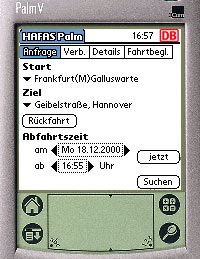 If you’re a regular train traveller across the UK, or you’re planning a holiday involving lots of different journeys, keeping track of all the various train times can be a bit of a pain.
If you’re a regular train traveller across the UK, or you’re planning a holiday involving lots of different journeys, keeping track of all the various train times can be a bit of a pain. Then it’s a case of bashing the ‘create’ buttom and waiting for a few minutes as the Teutonic technlogoy does it thing, before being presented with links to your timetable (you can elect to download the timetable directly from the site or have the files emailed to you).
Then it’s a case of bashing the ‘create’ buttom and waiting for a few minutes as the Teutonic technlogoy does it thing, before being presented with links to your timetable (you can elect to download the timetable directly from the site or have the files emailed to you).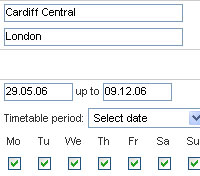 This small download provides a simple interface serving up enough timetable-related data to give train buffs a moist spot or two.
This small download provides a simple interface serving up enough timetable-related data to give train buffs a moist spot or two.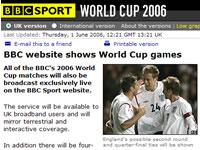 The BBC Sport Website will be carrying all of the World Cup 2006 football matches – Live. It will be only open to UK broadband users (or non-UK clever clogs who can set up a proxy or two).
The BBC Sport Website will be carrying all of the World Cup 2006 football matches – Live. It will be only open to UK broadband users (or non-UK clever clogs who can set up a proxy or two). Panic in the network departments of companies around the UK will be settling in tomorrow morning as they realise quite how many of the employees will be sneaking a watch of the matches while at work. We suspect that bosses will be sanctioning, or possibly even buying TV for the staff to watch, rather than have their networks melt around them.
Panic in the network departments of companies around the UK will be settling in tomorrow morning as they realise quite how many of the employees will be sneaking a watch of the matches while at work. We suspect that bosses will be sanctioning, or possibly even buying TV for the staff to watch, rather than have their networks melt around them. Thinner than a whippet with Montezuma’s Revenge, Fujifilm’s new FinePix Z3 sports a 5.1 million pixel sensor, ISO reaching down to the dim lights of 1600 and a 36-108mm (3x), F3.5 – 4.2 lens.
Thinner than a whippet with Montezuma’s Revenge, Fujifilm’s new FinePix Z3 sports a 5.1 million pixel sensor, ISO reaching down to the dim lights of 1600 and a 36-108mm (3x), F3.5 – 4.2 lens. (*A quick straw poll around the office found this claim to be total bollocks, by the way).
(*A quick straw poll around the office found this claim to be total bollocks, by the way).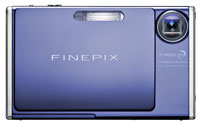 Specifications:
Specifications: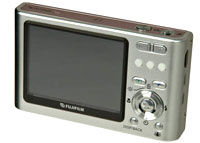 Modes – Auto, Anti-Blur, Scene Position, Macro, Movie, Burst / Continuous
Modes – Auto, Anti-Blur, Scene Position, Macro, Movie, Burst / Continuous LG has unveiled the KG810 clamshell phone; a super slim, quad band GSM handset which will be sold in Asia, China, Europe and CIS markets.
LG has unveiled the KG810 clamshell phone; a super slim, quad band GSM handset which will be sold in Asia, China, Europe and CIS markets.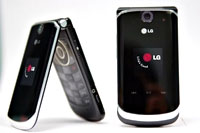 Under the screen there’s a touch-sensitive keypad and a fairly healthy 128 MB of internal memory.
Under the screen there’s a touch-sensitive keypad and a fairly healthy 128 MB of internal memory. Although these stars were clearly happy to scoop up any expensive freebies coming their way, when it came to electing the UK’s “primary Chocolate phone ambassador,” LG found the celebrity cupboard somewhat bare.
Although these stars were clearly happy to scoop up any expensive freebies coming their way, when it came to electing the UK’s “primary Chocolate phone ambassador,” LG found the celebrity cupboard somewhat bare.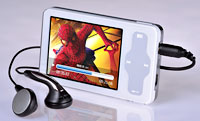 After consulting the well thumbed iPod design book, Chinese electronics manufacturers Meizu have rolled out their new Meizu Mini, a truly Lilliputian Personal Media Player.
After consulting the well thumbed iPod design book, Chinese electronics manufacturers Meizu have rolled out their new Meizu Mini, a truly Lilliputian Personal Media Player.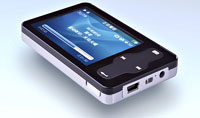 Other onboard gizmos include Synchronized Lyric Display, E-book, alarm clock, calculator, calendar and some (unspecified) games.
Other onboard gizmos include Synchronized Lyric Display, E-book, alarm clock, calculator, calendar and some (unspecified) games.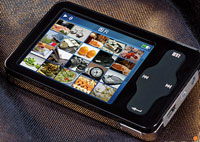 So far we’ve only seen Chinese language screen shots but the interface seems crisp and slick enough to us.
So far we’ve only seen Chinese language screen shots but the interface seems crisp and slick enough to us. The player comes with a white or black finish and a metal back just like the – yep, you’ve guessed it – iPod.
The player comes with a white or black finish and a metal back just like the – yep, you’ve guessed it – iPod.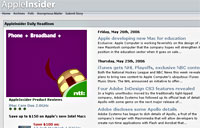 Apple’s attempt to identify the sources of leaked product information that appeared on Mac enthusiast websites has fallen flat on its face after a Californian court ruled that on-line reporters and bloggers are entitled to the same protections as traditional journalists.
Apple’s attempt to identify the sources of leaked product information that appeared on Mac enthusiast websites has fallen flat on its face after a Californian court ruled that on-line reporters and bloggers are entitled to the same protections as traditional journalists.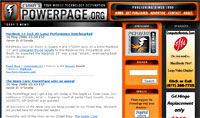 The court was having none of it, with a unanimous ruling giving the three online publications protection under the shield law, as well as the constitutional privilege against disclosure of confidential sources.
The court was having none of it, with a unanimous ruling giving the three online publications protection under the shield law, as well as the constitutional privilege against disclosure of confidential sources.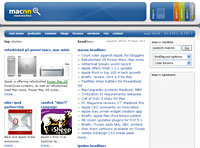 “The shield law is intended to protect the gathering and dissemination of news, and that is what petitioners did here,” added Justice Rushing.
“The shield law is intended to protect the gathering and dissemination of news, and that is what petitioners did here,” added Justice Rushing.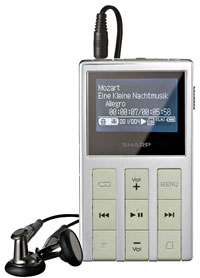 Details are still a bit sketchy on these shiny new fellas, but Sharp’s new range of flash based MP3 players sure look mighty purdy to our jaded eyes.
Details are still a bit sketchy on these shiny new fellas, but Sharp’s new range of flash based MP3 players sure look mighty purdy to our jaded eyes.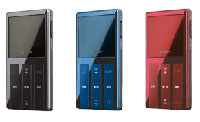 As is de rigueur these days with (non Apple) MP3 players, there’s an FM tuner onboard with direct audio encoding – great for recording radio shows or capturing your mobile mumblings via the built in microphone
As is de rigueur these days with (non Apple) MP3 players, there’s an FM tuner onboard with direct audio encoding – great for recording radio shows or capturing your mobile mumblings via the built in microphone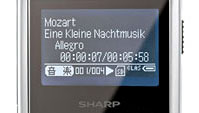 The measurements of the MP-B200 and MP-B300 are 49 x 87.6 x 8.9mm – pretty damn small, but positively bun-scoffing compared to 6.8mm thickness of the Apple iPod.
The measurements of the MP-B200 and MP-B300 are 49 x 87.6 x 8.9mm – pretty damn small, but positively bun-scoffing compared to 6.8mm thickness of the Apple iPod.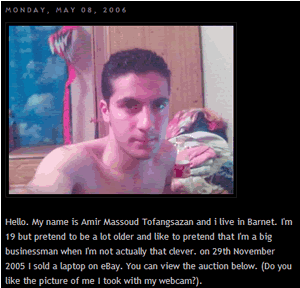 A number of people that we know who have at one time or another had very serious eBay habits have, at one time or another have been ripped off on eBay. Some see it as a right of passage, one that makes you pay that little bit more attention the next time.
A number of people that we know who have at one time or another had very serious eBay habits have, at one time or another have been ripped off on eBay. Some see it as a right of passage, one that makes you pay that little bit more attention the next time.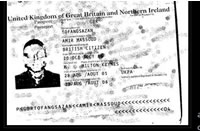 When you realise this is the case you then get angry; contact eBay; they tell you about the scheme they have in place to provide financial recompense; you find out it’s actually not worth doing because the difference between what you paid and the admin charge makes it not worthwhile. You put it down to experience.
When you realise this is the case you then get angry; contact eBay; they tell you about the scheme they have in place to provide financial recompense; you find out it’s actually not worth doing because the difference between what you paid and the admin charge makes it not worthwhile. You put it down to experience. All of those children who have been struggling to get their parents to buy them the playground-must-have, an iPod, now have the ultimate excuse – “But it’s for my edukashon!”
All of those children who have been struggling to get their parents to buy them the playground-must-have, an iPod, now have the ultimate excuse – “But it’s for my edukashon!” Deja Vu
Deja Vu Students will be able to download study guides that work with Pearson’s educational texts and listen to review notes to prepare for exams.
Students will be able to download study guides that work with Pearson’s educational texts and listen to review notes to prepare for exams. Apple has used this approach previously. Many years ago Apple started selling their computers to school children at a discount, with the logic that if they were hooked early, they’d be in the Apple-way for the rest of their lives.
Apple has used this approach previously. Many years ago Apple started selling their computers to school children at a discount, with the logic that if they were hooked early, they’d be in the Apple-way for the rest of their lives.